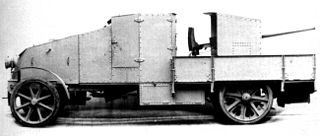
An armoured fighting vehicle or armored fighting vehicle (AFV) is an armed combat vehicle protected by armour, generally combining operational mobility with offensive and defensive capabilities. AFVs can be wheeled or tracked. Examples of AFVs are tanks, armoured cars, assault guns, self-propelled artilleries, infantry fighting vehicles (IFV), and armoured personnel carriers (APC).

A military armoredcar is a lightweight wheeled armored fighting vehicle, historically employed for reconnaissance, internal security, armed escort, and other subordinate battlefield tasks. With the gradual decline of mounted cavalry, armored cars were developed for carrying out duties formerly assigned to light cavalry. Following the invention of the tank, the armored car remained popular due to its faster speed, comparatively simple maintenance and low production cost. It also found favor with several colonial armies as a cheaper weapon for use in underdeveloped regions. During World War II, most armored cars were engineered for reconnaissance and passive observation, while others were devoted to communications tasks. Some equipped with heavier armament could even substitute for tracked combat vehicles in favorable conditions—such as pursuit or flanking maneuvers during the North African Campaign.

The AMX-13 is a French light tank produced from 1952 to 1987. It served with the French Army, as the Char 13t-75 Modèle 51, and was exported to more than 26 other nations. Named after its initial weight of 13 tonnes, and featuring a tough and reliable chassis, it was fitted with an oscillating turret built by GIAT Industries with revolver-type magazines, which were also used on the Austrian SK-105 Kürassier. Including prototypes and export versions, over a hundred variants exist, including self-propelled guns, anti-aircraft systems, APCs, and ATGM versions.

The Saint-Chamond was the second French tank to enter service during the First World War, with 400 manufactured from April 1917 to July 1918. Although not a tank by a strict definition of a heavily armoured turreted vehicle, it is generally accepted and described as such in accounts of early tank development. It takes its name from the commune of Saint-Chamond where its manufacturers Compagnie des forges et aciéries de la marine et d'Homécourt (FAMH) were based.

AEC Armoured Car is the name of a series of British heavy armoured cars built by the Associated Equipment Company (AEC) during the Second World War.

The M3 Scout Car was an American-produced armored car. The original M3 Scout Car was produced in limited numbers, while the improved M3A1 Scout Car saw wide service during World War II and after.

The Marmon-Herrington Armoured Car was a series of armoured vehicles that were produced in South Africa and adopted by the British Army during the Second World War. RAF Armoured Car companies possessed them, but seem never to have used them in action, making greater use of Rolls-Royce Armoured Cars and other types.

The Guy Armoured Car was a British armoured car produced in limited numbers during Second World War. The car saw limited action during the Battle of France.

The Hotchkiss H35 or Char léger modèle 1935 H was a French cavalry tank developed prior to World War II. Despite having been designed from 1933 as a rather slow but well-armoured light infantry support tank, the type was initially rejected by the French Infantry because it proved difficult to steer while driving cross-country, and was instead adopted in 1936 by the French Cavalry arm.

Car, Armoured, Heavy (Aust), also known as Rhino, was an armoured car designed in Australia during the Second World War. Due to enemy action and design problems the project never got beyond a prototype stage.

The Laffly S15 was a family of all-terrain military vehicles from French manufacturer Laffly that shared the same six-wheel drive chassis. They were used by French forces during World War II.

The Peugeot armoured car was a four-wheeled armoured vehicle based on a commercial Peugeot truck that was quickly developed by the French in 1914 for use during the First World War.

The T17 armored car, sometimes referred to as the M5 medium armored car and by the British as the Deerhound, was an American six-wheeled armored car produced during the Second World War.

The Autocanon de 47 Renault was an armoured car designed by Renault in 1915.

The White AM armoured car was a French First World War armoured car that was built on a commercial American White Motor Company truck chassis with armoured bodies supplied by the French firm Ségur & Lorfeuvre, it was used by the French military from its introduction in 1915. Between the wars the French military completely rebuilt the vehicles as the White-Laffly AMD 50 and the Laffly-Vincennes AMD 80, in these guises it served until at least 1943.
















